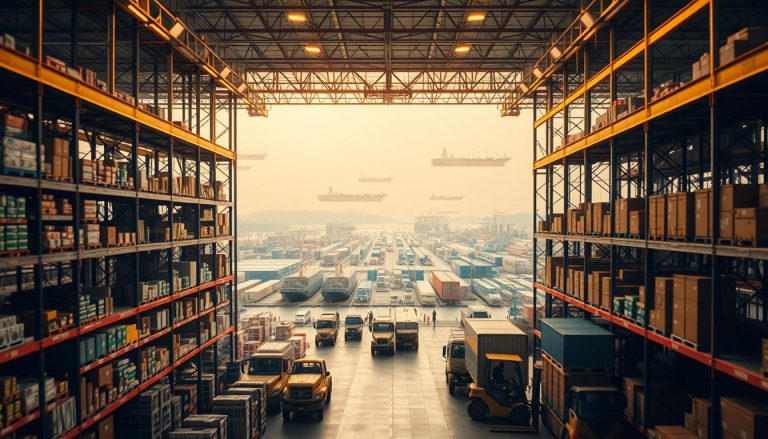Optimize Logistics with Supply Chain Solutions
U.S. shippers are grappling with rising costs, labor shortages, and unpredictable service levels. Executives seek supply chain solutions that streamline planning, execution, and compliance without increasing complexity. This section explores how logistics management, backed by technology integration, can enhance speed, accuracy, and control in both national and cross-border networks.
Descartes offers cloud-based logistics platforms that integrate carriers, brokers, forwarders, and shippers through a vast network. The Descartes Logistics Technology Platform combines B2B connectivity, EDI messaging, transportation management, routing, mobile telematics, ecommerce fulfillment, and global trade intelligence. This unified model for United States logistics efficiently moves inventory, information, assets, and people.
Case studies highlight the effectiveness of these solutions. Estes Logistics scaled long-term, achieving a 500% productivity gain in ecommerce for ESPAS and Steinehelden. Fairmont Tire & Rubber increased delivery capacity through last-mile optimization.
Brav Norway sped up bonded warehouse operations, GHY streamlined cross-border customs, and Adafruit Industries simplified denied party screening. These examples demonstrate how technology integration minimizes errors, elevates service levels, and safeguards profit margins.
Descartes also conducts consumer sustainability research, gathering insights from over 8,000 respondents in the United States, Canada, and nine European countries.
The research informs logistics management decisions, from routing to packaging, that meet consumer preferences and regulatory standards. These supply chain solutions and cloud-based logistics platforms offer a practical roadmap for resilient, data-driven operations in United States logistics.
Understanding the Logistics Challenge and the Cost of Inefficiency
Supply chains are under immense pressure due to rising volatility, tight labor markets, and complex regulations. Logistics management must now control costs and service quality while protecting working capital. Achieving this requires accurate demand forecasting, precise transportation planning, and disciplined inventory optimization. These strategies help reduce delays and waste.
Data from parcel carriers, ocean schedules, and warehouse execution systems reveal performance gaps. Warehouse automation helps stabilize throughput during order spikes. When planning and execution processes align, cycle times decrease, and exceptions diminish.
Delayed deliveries, quality issues, and inventory mismanagement
Delays lead to expediting and overtime, causing dock congestion and extended dwell times. Quality defects result in rework and returns, increasing reverse flows and freight touches.
Poor inventory optimization causes stockouts that lose sales and overstocks that lock up cash. Weak demand forecasting exacerbates these issues, distorting purchase plans and safety stock.
How logistics failures impact customer experience and margins
Missed delivery windows undermine reliability metrics and increase last-mile costs. Service penalties and retailer chargebacks compress gross margin. Return handling, repacking, and disposal further widen the cost gap.
Inaccurate transportation planning leads to empty miles and detours. Customers face longer lead times, and contact centers handle more inquiries. The brand loses repeat orders, resulting in a measurable loss.
Identifying bottlenecks across transportation, warehousing, and compliance
End-to-end visibility is key to identifying root causes. Teams map out routing, dispatch, and dock scheduling to pinpoint queues. Telemetry flags slow handoffs between modes and carriers.
Inside facilities, scans and pick-path data expose congestion and idle time. Warehouse automation metrics—throughput, picks per hour, and error rates—reveal constraints. Compliance workflows for customs and partner government agencies are checked for submission delays and document defects.
- Transportation planning: analyze lane variability, appointment adherence, and dwell.
- Inventory optimization: compare forecast error to service level and carrying cost.
- Demand forecasting: recalibrate horizons, seasonality, and promotion effects.
- Logistics management: align KPIs across procurement, operations, and finance.
Building a Connected Logistics Network with Technology Integration
Enterprises are now merging disparate tools into a unified logistics management framework. This integration links various aspects of logistics, such as orders, shipments, and financial transactions, across different partners, modes, and regions. The outcome is a network that reduces delays, enhances data accuracy, and enables faster, more precise operations.
B2B connectivity and EDI messaging to collaborate with trading partners
Standardized B2B connectivity and EDI messaging ensure seamless exchange of critical logistics data. Descartes facilitates direct interaction among carriers, shippers, brokers, and forwarders through a vast, shared network. This approach minimizes errors and expedites the integration of new partners, all without the need for extensive custom coding.
Estes Logistics has successfully operated a scalable dedicated fleet for over 15 years. ESPAS and Steinehelden have also seen significant productivity boosts in their ecommerce operations through disciplined data exchange and effective exception handling. These achievements underscore the importance of structured data formats and event-driven integration.
Unifying data across planning, dispatch, mobile, and telematics
Integrating data from various sources—planning, dispatch, mobile apps, and telematics—yields substantial gains in fleet productivity. This integration ensures that route planning, driver execution, and real-time location data are all connected. This connection enables precise ETA calculations and timely alerts, making exception management more efficient and consistent.
Descartes merges routing, mobile, and visibility tools to standardize critical milestones and geofencing logic. This approach reduces manual checks, enhances asset utilization, and ensures service-level compliance across different regions. The outcome is fewer missed delivery windows and improved on-time performance.
Leveraging cloud-based logistics management platforms
Cloud-based logistics platforms consolidate various logistics functions, including transportation, ecommerce fulfillment, and compliance, into a single environment. This model significantly reduces IT costs, accelerates deployment, and supports rapid scaling during peak seasons.
Descartes connects these platforms with global trade intelligence, providing real-time inventory updates, shipment milestones, customs filings, and restricted party screening.
Centralized logistics management enhances planning accuracy and shortens resolution times for rate disputes and delivery claims. The elastic infrastructure supports the addition of new lanes, carriers, and service levels without requiring significant capital investments. This results in a robust network, built on proven technology integration and reliable B2B connectivity, supported by robust EDI messaging.
Supply Chain Solutions
Comprehensive supply chain solutions merge planning, execution, and compliance into a unified model. Descartes supports this model with various capabilities. These include transportation management, routing, and mobile telematics, as well as ecommerce fulfillment and customs compliance. These functions integrate with broker and forwarder systems, backed by restricted party screening and trade intelligence.
DSV focuses on network optimization through advanced data analytics and algorithms. Its teams analyze supplier locations, distribution centers, and transportation routes. The goal is to enhance performance while managing risk effectively within disciplined logistics management.
DSV’s diagnostic process begins with evaluating transportation routes and warehouse locations. It also considers inventory positions and order fulfillment patterns. Predictive modeling and real-time tracking reveal inefficiencies. Tools like MyDSV offer shipment visibility, while Multi LSP POM SCM Services combine data from multiple suppliers into one dashboard for actionable insights.
These supply chain solutions streamline end-to-end logistics management, leading to faster delivery, cost savings, and increased resilience. Embedded trade intelligence enhances screening and documentation quality. Governance frameworks ensure alignment with sustainable practices, based on consumer research and emissions targets.
Organizations can adopt these solutions in phases, starting with transportation, warehousing, ecommerce fulfillment, and compliance. Each phase benefits from network optimization models that simulate scenarios before implementation.
This approach enables a controlled rollout with measurable KPIs, audit-ready records, and a foundation for ongoing improvement in sustainable practices.
Transportation Management and Planning for Multimodal Efficiency
Transportation management systems integrate various modes, carriers, and sites into a unified control layer. This enables teams to manage ocean, rail, truckload, less-than-truckload, parcel, and final mile operations on a single timeline. Such an approach optimizes routes while maintaining consistent service levels across the network.
Descartes offers real-time visibility across modes, aiding planners in managing capacity, exceptions, and carrier performance. Estes Logistics achieved significant fleet utilization gains with Descartes. This highlights the effectiveness of integrated systems in scaling operations without increasing miles.
End-to-end visibility to view, optimize, and manage transportation operations
End-to-end visibility merges shipments, routes, and events into a single, live view. Teams can dynamically re-sequence routes to recover time lost to delays, ensuring delivery windows are met. Performance dashboards compare planned versus actual performance, focusing on cost, on-time delivery, and dwell times. This enhances logistics management at both lane and carrier levels.
- Real-time milestones and geofence alerts streamline exception handling.
- Carrier scorecards quantify tender acceptance, OTIF, and claims.
- Predictive ETAs enable proactive customer updates and slot adherence.
Route design, dispatch, and mobile telematics to improve fleet productivity
Route design tools minimize empty miles and time on the road through precise territory planning and stop sequencing. Dispatch orchestration ensures driver shifts, trailer availability, and dock capacity align with demand. Mobile telematics provides turn-by-turn guidance, proof-of-delivery, and real-time stop status.
- Route optimization balances service time, traffic, and legal hours-of-service.
- Mobile telematics captures ePOD, photos, and signatures to shorten invoicing cycles.
- Geospatial heat maps flag recurring bottlenecks for targeted corrections.
Balancing costs, service levels, and sustainability in transportation planning
Analytics help quantify the trade-offs between cost per stop, asset utilization, and emissions. Consumer research from Descartes reveals that greener options influence delivery choices. Planners test various time windows, consolidation rules, and vehicle mixes to align with sustainable practices.
- Scenario modeling evaluates linehaul consolidation versus last-mile speed.
- Fleet mix analysis compares diesel, electric, and alternative fuels on TCO and CO2e.
- KPIs integrate transportation planning metrics with sustainability targets for ongoing review.
Inventory Optimization and Warehouse Automation
Top logistics teams merge inventory optimization with warehouse automation. This approach aligns stock, labor, and transport. Demand forecasting across nodes reduces carrying costs while maintaining service levels. Integrated execution links storage decisions to last-mile outcomes.
Right-sizing inventory levels with demand forecasting
Right-sizing inventory begins with demand forecasting by channel, SKU, and node. Safety stock and reorder points are set based on service targets, lead times, and variability. DSV uses a network optimization framework to align inventory policies with fulfillment paths.
Predictive modeling allocates stock by region and tests seasonality scenarios. This method reduces stockouts and markdown risk while maintaining response time.
Automating pick, pack, and ship for ecommerce fulfillment
In high-velocity ecommerce, automation boosts accuracy and throughput. Descartes warehouse solutions manage pick, pack, and ship with mobile scanning and intelligent waves. Results include a 500% productivity increase at ESPAS and Steinehelden.
Combining warehouse execution with transportation management and telematics provides real-time availability to the delivery network. This leads to faster order cycle times and fewer exceptions at the dock.
Designing warehouse locations for network optimization
Warehouse placement is based on simulations testing service coverage, transportation cost, and cycle times. DSV evaluates inventory levels and order flows to remove bottlenecks through data analytics. Bonded warehouse acceleration at Brav Norway (Swix) shows the benefit of integrated compliance within operations.
Scenario design compares regional nodes, cross-docks, and urban micro-fulfillment. The analysis guides network optimization, balancing capital use with customer proximity and carrier performance.
Global Trade, Customs, and Regulatory Compliance
Cross-border logistics thrives on the efficiency of accurate filings. Embedding regulatory compliance and customs management in daily operations accelerates shipment clearance. This integration ensures costs remain stable and delivery dates are met.
Descartes offers automated solutions for security filings, customs declarations, and submissions to U.S. CBP, Canada Border Services Agency, and the EU Customs Union. These tools help brokers and forwarders digitize entries, reference data, and accounting. This process minimizes manual errors and shortens the cycle time.
Case studies reveal significant improvements. GHY enhanced customs clearance by standardizing data capture and electronic submissions through Descartes. This move improved release times and audit readiness. Adafruit Industries, on the other hand, streamlined denied party controls with Descartes’ restricted party screening. This integration reduced risk while maintaining order flow.
Global trade intelligence provides critical insights into tariff codes, duty rates, and free trade agreement eligibility. Teams use this analysis to classify goods, validate country-of-origin rules, and forecast landed cost. This is complemented by restricted party screening, ensuring due diligence is consistently applied. This approach supports margin protection across import and export lanes.
When compliance data is integrated into dispatch and yard schedules, cross-border logistics becomes more resilient. Carriers receive cleared loads sooner, warehouses can slot inbound inventory with confidence, and finance can accurately book duties and taxes. This unified process links customs management, regulatory compliance, and global trade intelligence from purchase order to proof of delivery.
- Automated filings: ACE, AES, and partner agency entries submitted in-system.
- Data continuity: product classification and documents synchronized with TMS and WMS.
- Risk controls: restricted party screening applied at quote, order, and shipment.
- Operational impact: fewer holds, lower penalties, and tighter on-time performance.
Vendor Management and Trade Intelligence
Disciplined vendor management, backed by trade intelligence and structured data exchange, is key to better sourcing outcomes. It enables teams to manage onboarding, screening, and performance tracking effectively. This approach also enhances cycle times in purchase-to-pay and order-to-cash processes.
Vetting trading partners with restricted party and global trade data
Descartes global trade intelligence is used by compliance teams to screen against denied and restricted party lists. These lists are maintained by the U.S. Department of Commerce, OFAC, and the European Union. This method helped Adafruit Industries streamline denied party screening, reducing manual checks and false positives.
This approach integrates risk management with EDI messaging. It ensures approvals, holds, and audit trails are directly communicated to sourcing and finance. This reduces onboarding time and prevents penalties, while preserving margin.
Using market intelligence to maximize margins and reduce risk
Market and lane-level data inform award decisions, safety stock, and supplier allocations. Shipment visibility and lead-time variance analysis guide pricing and replenishment. This improves fill rates during demand spikes.
Blending trade intelligence with cost-to-serve metrics supports precise risk management. Planners can adjust tender strategy, diversify lanes, and renegotiate terms when volatility rises.
Coordinating brokers and forwarders with digitized workflows
Broker and forwarder systems digitize customs entries, documents, and billing. This creates a single record from origin to delivery. EDI messaging links suppliers, customs brokers, and carriers, cutting exceptions and shortening clearance.
Finance, compliance, and logistics gain synchronized data for audits and claims. This results in fewer delays, faster reconciliation, and consistent service levels across ports and modes.
| Capability | Operational Function | Measured Outcome | Example Tools |
|---|---|---|---|
| Restricted Party Screening | Automated vetting across orders and vendors | Lower compliance risk; reduced manual reviews | Descartes trade intelligence; OFAC and BIS lists |
| Market and Lane Analytics | Price, lead-time, and allocation modeling | Higher margins; improved service reliability | Benchmark cost indices; shipment visibility platforms |
| EDI Messaging | Structured purchase, booking, and invoice data | Fewer exceptions; faster cycle times | ANSI X12 850/810/856; UN/EDIFACT |
| Broker and Forwarder Systems | Digitized customs, documents, and accounting | Improved clearance speed; complete audit trail | Enterprise broker platforms; customs entry software |
| Risk Management Controls | Real-time alerts and holds during onboarding | Fewer fines; stronger governance | Screening rules; exception workflows |
Industry-Specific Logistics Strategies
Different sectors have unique challenges, from varying risk profiles to specific regulatory demands. Effective logistics strategies must consider network design, transportation planning, and supply chain integration. These elements must align service levels with cost targets.
Industry leaders leverage transportation management, warehouse automation, and trade intelligence. They also focus on strict healthcare compliance. Tailoring capabilities to each market has led to significant gains for recognized brands.
Automotive and industrial: meeting production schedules and managing complexity
Automotive and industrial sectors operate on tight schedules and precise sequences. They face volatility due to tiered supplier networks, requiring robust transportation planning and contingency lanes. DSV excels in synchronizing inbound flows with production calendars, stabilizing inventory.
Route engineering, vendor-managed inventory, and time-definite milk runs benefit plants. These strategies reduce changeover delays, lower premium freight costs, and protect throughput during shortages.
Technology and healthcare: resilience and regulatory compliance
Technology logistics must adapt to short product lifecycles and launch spikes. It requires secure chain-of-custody, high-value handling, and rapid reverse flows. These support warranty and refurbishment programs.
Healthcare logistics demands documented cold chain, lot-level traceability, and alignment with FDA, DEA, and HIPAA. Temperature mapping, validated packaging, and serialized tracking lower spoilage risk and prevent customs holds. Integrated supply chain solutions ensure audit-ready records.
Consumer and retail: faster distribution and last-mile performance
Consumer logistics emphasizes speed, delivery windows, and unit economics. Descartes’ last-mile tools increased delivery capacity and distribution efficiency at Fairmont Tire & Rubber. Ecommerce fulfillment systems scaled throughput for ESPAS and Steinehelden.
Optimizing networks across store replenishment, micro-fulfillment, and parcel carrier mix improves on-time rates and reduces miles. Data-driven transportation planning balances cost, service, and density for sustained growth across seasons.
Driving Sustainable Practices Across the Supply Chain
Retailers and carriers now prioritize climate impact in their decisions. A Descartes survey of over 8,000 consumers in the U.S., Canada, and Europe revealed a shift in delivery preferences when greener options are available. Age and location influence these choices, making logistics management essential for aligning offers with local demand.

Aligning delivery choices with consumer sustainability preferences
Customers are willing to accept longer delivery times or consolidated drops when the environmental benefits are clear. Clear labels at checkout, like “least-emissions day,” encourage sustainable choices without coercion. Carriers can offer alternatives based on service levels and demand data, steering volume to off-peak hours to reduce congestion and emissions.
Brands like UPS and FedEx publish carbon data for specific services, helping merchants tailor their offerings by region and age. The mix of merchandise and order size also affects acceptance rates, making targeted incentives like free economy delivery for consolidated orders more effective.
Reducing emissions through route optimization and warehouse efficiency
Planners reduce fuel consumption through route optimization, improving load factors and sequencing stops. Telematics helps drivers improve their driving habits, further reducing emissions. Dynamic re-routing around traffic also minimizes idle time and empty miles.
Warehouse efficiency gains come from automation, slotting, and right-sized facilities. Situating facilities near demand centers shortens linehaul distances. Network redesigns, as seen with DSV, can lower total miles and exposure to congestion, while faster cycle times reduce energy use per order.
Measuring progress with analytics and reporting
Analytics and reporting provide insights into emissions per order, lane, and service level, making trade-offs clear to finance and operations. Sustainability metrics embedded in transportation and fulfillment systems standardize data capture and support compliance with emerging standards.
Dashboards track trends across depots, routes, and vehicle classes, linking interventions to outcomes. With accurate baselines, teams can set realistic targets and refine sustainable practices without compromising customer service or network resilience.
Conclusion
Proven supply chain solutions bring significant benefits when planning and execution are aligned. Descartes exemplifies this through its unified network, cloud-based logistics, and global trade intelligence. These efforts enhance performance across the United States. Companies like Estes Logistics and Adafruit Industries have seen improvements in cycle times and on-time delivery rates.
DSV’s network optimization further refines these efforts by aligning routes and inventory with service and cost goals. This strategic approach ensures efficient operations. It’s evident that connecting trading partners, unifying data, and digitizing customs workflows are key steps. Automating ecommerce fulfillment and using analytics to track performance are also critical.
Inventory optimization is at the heart of these strategies. Implementing right-sized safety stock and system-directed putaway reduces working capital. Vendor management, including restricted party screening, minimizes compliance risks. These practices enhance forecast accuracy and stabilize lead times, protecting profit margins.
For U.S. operators, a clear roadmap exists. It involves leveraging technology to connect the network and embed inventory optimization in daily operations. Vendor management with data-driven controls is also essential. By focusing on route design and telematics with clear KPIs, leaders can improve cost-to-serve and sustainability. This approach ensures reliable performance, making modern supply chain solutions scalable and repeatable.
FAQ
How do supply chain solutions improve logistics performance for U.S. operations?
Supply chain solutions integrate various aspects to enhance logistics performance. They include transportation management, routing, and inventory optimization. Descartes’ cloud-based platform offers B2B connectivity, EDI messaging, and global trade intelligence. This enables synchronized operations and compliance, leading to improved service levels and cost control.
Estes Logistics achieved long-term scaling, while ESPAS and Steinehelden saw a 500% increase in ecommerce productivity. Fairmont Tire & Rubber also improved last-mile delivery capacity.
What are the most common logistics inefficiencies and their financial impact?
Common logistics inefficiencies include delayed deliveries and inventory mismanagement. These issues lead to increased costs and tied-up working capital. Bottlenecks occur in transportation coordination and customs filings.
These problems compress margins through surcharges and lost sales. End-to-end visibility and process mapping are essential to identify and fix these issues.
How does technology integration with B2B connectivity and EDI enhance collaboration?
Technology integration through B2B connectivity and EDI messaging synchronizes data across the supply chain. Descartes’ Logistics Technology Platform integrates planning and dispatch, improving exception management. This leads to faster decision-making and higher fleet productivity.
Manual errors are reduced, and downstream service failures decrease.
What role do transportation management systems play in multimodal efficiency?
Transportation management systems provide visibility for planning and execution across modes. They enable dynamic re-sequencing and carrier performance monitoring. This leads to better asset utilization and emissions reduction.
Estes Logistics’ long-term scaling with Descartes demonstrates durable productivity gains and consistent service reliability.
How can demand forecasting and inventory optimization reduce stockouts and overstocks?
Demand forecasting aligns inventory with expected consumption. DSV’s network optimization framework positions stock strategically. Combining this with warehouse automation and transportation planning improves last-mile performance.
This reduces cycle times and working capital while maintaining fill rates.
What warehouse automation capabilities drive ecommerce throughput?
Automation in pick, pack, and ship processes scales order processing with high accuracy. Descartes’ ecommerce fulfillment tools connect warehouse execution with transportation management. This enables synchronized dock-to-door operations.
ESPAS and Steinehelden reported a 500% productivity improvement after deploying these capabilities.
How do companies streamline cross-border customs and regulatory compliance?
Digitized workflows manage security filings and customs declarations. Descartes’ compliance solutions combine global trade intelligence with restricted party screening. This reduces risk and avoids penalties.
GHY’s customs clearance was accelerated, and Adafruit Industries simplified denied party screening, demonstrating risk reduction.
What is the value of vendor management supported by trade intelligence?
Vendor management uses restricted party screening and market intelligence to validate partners. Descartes’ global trade intelligence centralizes restricted entities and trade data. EDI-enabled vendor portals reduce exceptions.
Broker and forwarder enterprise systems digitize documentation, customs steps, and accounting. This improves auditability and accelerates purchase-to-pay and order-to-cash processes.
How does network optimization guide warehouse siting and transportation planning?
Network optimization evaluates supplier locations and distribution centers using simulations and algorithms. DSV applies diagnostic analytics to align facility placement and routing with service and cost targets. This modeling quantifies trade-offs among delivery speed, transportation cost, and cycle time.
It enables resilient footprints with lower miles and congestion exposure.
Which industry sectors benefit most from integrated logistics management?
Automotive and industrial operations benefit from schedule adherence and complexity control. Technology firms need agile fulfillment for rapid product cycles. Healthcare depends on rigorous regulatory compliance.
Consumer and retail models require fast distribution and last-mile execution. Descartes’ last-mile tools increased delivery capacity at Fairmont Tire & Rubber, while ecommerce fulfillment scaled throughput for ESPAS and Steinehelden.
How can organizations embed sustainable practices without sacrificing service?
Route optimization, improved load factors, and telematics-driven driver behavior reduce fuel use and emissions. Warehouse efficiency—slotting, automation, and energy-aware siting—lowers consumption and cycle times. Descartes’ study shows environmental preferences influence delivery selection.
This guides planners to offer greener options while maintaining reliability.
What evidence supports the ROI of a unified logistics platform?
Descartes combines a large logistics network, logistics management applications, and global trade intelligence. This creates measurable outcomes: long-term dedicated fleet scaling at Estes Logistics, last-mile efficiency gains at Fairmont Tire & Rubber, and bonded warehouse acceleration at Brav Norway (Swix).
GHY’s customs clearance was accelerated, and Adafruit Industries simplified denied party screening, demonstrating risk reduction.







